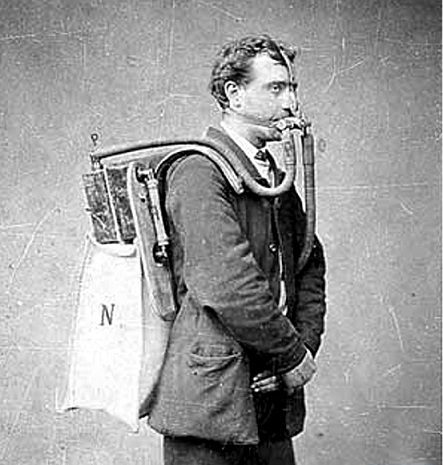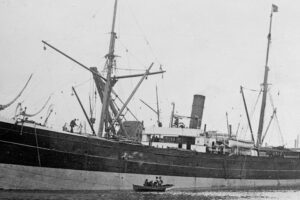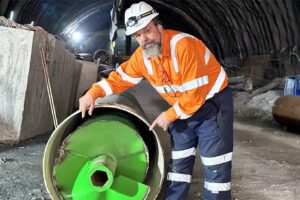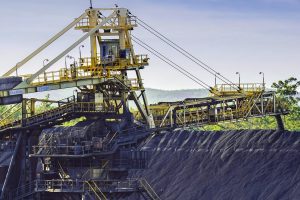Food, clothing and shelter may be the basic needs of humankind, but they pale in comparison to our most essential need of all; the need to breathe. Breathing apparatus can be fundamental to survival in a mine emergency. We look at the history of the development of breathing apparatus.
Clean air is vital to our survival and to our ability to perform physically at a high level. If you’ve ever been mountaineering in a place like Kilimanjaro, the Himalayas or the Andes in South America, you’ll be familiar with how the thin air at very high altitudes greatly affects movement. Walking becomes harder, lifting becomes harder, and even talking and thinking becomes harder as the neurons in the brain struggle to fire under reduced oxygen levels.
In an emergency situation in an underground mine, the ability of personnel to access clean oxygen is literally the difference between life and death. This is for obvious reasons – without clean oxygen to breath, the average human will experience some form of brain damage within 3 minutes, and die within 8.
However, just having some oxygen to breath is not enough. It has to be clean, plentiful and in constant supply or workers will experience the effects familiar to extreme altitude mountaineers – reduced physical and mental performance. In an underground emergency situation, impairment of any faculty is deadly. Reduced physical ability will prevent workers from getting to safety quickly and reduced mental ability prevents workers from making life-saving decisions and from communicating important information to their colleagues effectively.
Having quality and reliable breathing apparatus in an underground mining environment must be the number one equipment priority for any mine operator. Breathing apparatus is, quite literally, the breath of life in emergency situations, with every other consideration coming a distant second.
During the 19th century and first half of the 20th century, numerous lives could have been saved in mining accidents if reliable breathing apparatus technology had been available. While the principles behind operational breathing apparatus (or rebreathers) have been around since the 17th century, it wasn’t until after World War One that the technology started to become widely available to underground miners.
The oldest known patent for a rebreather was filed in 1808 in France by an engineer in Napoleon’s Navy, Sieur Touboulic. Touboulic’s rebreather delivered oxygen to the wearer progressively, circulating in a closed circuit through a sponge soaked in limewater. The invention didn’t exactly take off, but the idea was there.
The next attempt to develop practical breathing apparatus technology came in the 1820s with engineers designing equipment to protect fireman from smoke inhalation. In some countries, firefighters were known as “smoke-eaters”. These smoke-eaters faced dreadful health issues from breathing in the hot, noxious smoke produced by an intense building fire. They experienced severe breathing difficulties as well as burn damage to the trachea and even the lungs themselves.
The first breathing apparatus prototype to enjoy any level of success was a fetching little number that consisted of a full head leather hood supplied with oxygen by a hose strapped to the fireman’s leg. This hose dropped to the man’s shoes and drew oxygen, not from a chamber, but from the marginally better air to be found near the floor of a smoke-filled room. As the wearer inhaled, air would be drawn up through the hose and fill the leather hood.
This equipment, while certainly not ideal, at least enabled the fireman to remain upright and active in a smoke-filled environment for longer than he would have been able to previously.
Building on this rudimentary technology, a full body suit was soon designed that was able to be filled with clean air sourced from outside a burning building. This suit enabled the wearer to function in a smoky environment for short periods of time – perhaps enough time to rescue a person trapped by the fire.
Another design that didn’t generate much traction at the time was a leather air-filled backpack similar to some products available on the market today.
As well as firemen, underwater divers were also experimenting with self-contained breathing apparatus around this time with varying levels of success.
“In an emergency situation in an underground mine, the ability of personnel to access clean oxygen is literally the difference between life and death.”
 Types of self-contained breathing apparatus
Types of self-contained breathing apparatus
OPEN & CLOSED CIRCUIT
Self-contained breathing apparatus can be divided into two main categories: open circuit systems and closed circuit systems.
An open circuit system supplies the wearer with fresh oxygen and releases the carbon dioxide expelled by the wearer to the outside atmosphere through a valve in the facepiece.
A closed circuit system recirculates expelled air through the apparatus, taking out the carbon dioxide and adding fresh oxygen. The wearer then breathes in oxygen-enriched air.
PRIMARY & AUXILIARY
In mine rescue work, breathing apparatus are classified as primary or auxiliary apparatus according to the amount of oxygen supplied. Primary apparatus are apparatus that have a minimum of 2 hours’ service time. Auxiliary apparatus are units which provide, 30 to 60 minutes’ service time.
Primary apparatus are the standard apparatus used by mine rescue teams.
“Another design that didn’t generate much traction at the time was a leather air-filled backpack similar to some products available on the market today.”
It wasn’t until the mid 19th century that breathing apparatus for underground mine workers was first considered. In 1853, German Professor Theodore Schwann entered a self-contained breathing apparatus in a competition of the Belgian Academy of Science and exhibited it at an industrial fair in Belgium. Schwann’s apparatus had a large back-mounted oxygen tank with a working pressure of about 13.3 bar and two scrubbers containing sponges soaked in caustic soda.
This first attempt stoked the fires of invention and in 1880, Henry Fleuss, a marine engineer, used self-contained breathing apparatus to explore Seaham Colliery in the UK in the aftermath of a gas explosion. Unfortunately 164 lives were lost in the accident.
Fleuss’s invention stored oxygen and absorbed carbon dioxide through a rope soaked in a caustic potash solution. This was the first time (that we know of) that breathing apparatus was used, professionally, in an underground mine environment.
Fleuss, in partnership with dive equipment manufacturer, Siebe Gorban, then developed the Proto Breathing Apparatus in 1911 as well as a breath-controlled dispenser known as the automatic lung.
In Australia, the importance of breathing apparatus in underground mining came into focus during Tasmania’s Mount Lyell mine disaster of 1912.
The tragedy unfolded around 11.15am on 12 October 1912 when a fire was reported in the pump house of the 700 foot level. Out of 170 workers, only 73 men escaped on the first day. Those that had not already died, remained trapped.
The rescue effort was one of the biggest undertaken for the time. Fire crews and vital breathing apparatus were rushed by train in record time from Hobart and also shipped from Bendigo in Victoria, across Bass Strait. The S.S.Loongana, the ship which crossed the Strait carrying the breathing apparatus, made the crossing in 13 hours, 35 minutes – a record which stood for many years. Rescue efforts continued for four days with the last of the survivors brought to the surface more than 100 hours after their eight hour shift began.
Surprisingly, considering how many lives were taken, the Mount Lyell disaster did not involve an explosion, gas leak, earthquake or cave-in.
The fire itself was not particularly dangerous, however the smoke it produced and the oxygen it consumed stole the breath from the trapped miners’ lungs and ultimately took their lives. Many miners who initially survived and made it to the surface later succumbed due to lungs irreparably ravaged by smoke and fumes.
How much different would the result have been if the workers had access to breathing apparatus technology at the time of the initial fire? Many more men would have made it home to their families that night.
In 1923, a coronial inquest and Royal Commission into the Bellbird mine disaster in New South Wales extensively debated the value of breathing apparatus and the establishment of central rescue stations. As a result, the first mines rescue station in NSW began operations in 1926 at Abermain. Stations in Newcastle, Wollongong and Lithgow opened shortly after.
Self-contained breathing apparatus received glowing reviews in the Queensland Times in 1928 in the paper’s reporting of the Redbank Colliery mine disaster. While 3 men perished in the explosion, the rescue and recovery operation was only made possible due to breathing apparatus worn by the rescue party. The Queensland Times describes the equipment:
“At the Rescue Station at Bundanba there is a special room for gas practice. It is filled with smoke, fumes, or gases that would kill any man going into it without special breathing apparatus, and in this, training is given in the use of gas masks. Breathing in these respirators alone requires much practice. The nose is closed by a clamp, and all breathing must be through the mouth. The heaviest piece of the apparatus, which weighs about 40lb, is the double oxygen cylinder in which oxygen is carried compressed to 1800lb per square inch. Breathing is from a big rubber bag, into which the oxygen is released through a control valve. The carbon dioxide of the exhaled breath, itself asphyxiating, is turned into hydrogen by contact with caustic soda, and, mixing with the oxygen, forms normal air.”
The development of self-contained breathing apparatus has continued to progress through the years. In Australia now, underground mine workers are required to have a self-rescuer on their person at all times. These self-rescuers are closed circuit chemical oxygen devises with a carbon monoxide filter and provide the wearer around 60 minutes of air – enough time to get to safety.
Wide application of self-rescuers was introduced into Australian underground mines following the 1994 Moura No. 2 mine disaster in Queensland that killed 11 miners. Self-rescuers replaced a filter type that converted toxic carbon monoxide to carbon dioxide. These filter-type apparatus were deemed ineffective in the oxygen-deleted environment created in the aftermath of an explosion.
The Wardens Inquiry into the disaster stated, “a possibility that had they been able to put on their filter self-rescuers these devices may still have been ineffective in supporting life due to conditions of low oxygen or high carbon monoxide, or a combination of both, arising from the first explosion.”
Australian underground mines are now also equipped with compressed air breathing apparatus (CABA) including spare oxygen cylinders. CABA wearers can refill their units in less than two minutes without having to remove their masks, safeguarding them against exposure to deadly gases and airborne contaminants. CABA masks are also equipped with technology that facilitates communication between crew members and also allows the wearer to speak into phones.
CASE STUDY
SELF-RESCUER FAILURE AT PIKE RIVER
While self-contained respiratory technology has developed in leaps and bounds over the past century, breathing apparatus equipment will only save lives if it works!
This sombe reality was driven home to many in the aftermath of New Zealand’s Pike River mine tragedy in 2010. The Royal Commission learned that the self-rescuers in the mine were faulty. They learned this from one of only two people who survived the tragedy, Daniel Rockhouse:
“…Within seconds a pungent strong smell, and dense smoke, reached the area. The atmosphere was warm and breathing became difficult.
To escape the effects, Daniel Rockhouse went inbye towards the crushing station. It was clearer, but there was no place of refuge. He donned and activated his self-rescuer and moved back out to the main drift. The self-rescuer did not seem to be working properly so he discarded it. In the drift, next to his loader, he was overcome and fell to the ground again. He shouted for help, but there was no response. His eyes watered, his body tingled and he thought he was ‘shutting down’. He lapsed into unconsciousness.
After some time he revived … Eventually he managed to stand, fell again and then was able to reach compressed air and water lines that ran along the rib. He turned on an outlet valve on the air line. There was only limited pressure, but enough flow to clear the smoke from around him. The fresh air was ‘like gold’.
About 300m outbye he encountered a vehicle stationary in the drift. A few metres beyond it, he found Russell Smith lying semi-conscious on the ground, with his eyes open, but rolling back in his head…. Daniel Rockhouse removed Mr Smith’s self-rescuer from his belt, opened it and tried to insert the mouthpiece into the other man’s mouth. He could not do so. Daniel Rockhouse discarded the self-rescuer, lifted Mr Smith from behind and dragged him outbye towards the FAB.
Source
Royal Commission on the Pike River Coal Mine Tragedy. Final Report. Testimony of survivor, Daniel Rockhouse. Vol 2 – Part 1 page 24-25.















Add Comment